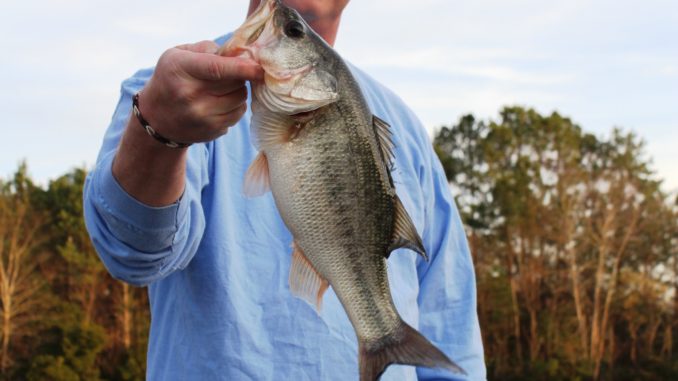
Dense stands of flooded cypress trees offer adventuresome anglers with plenty good fishing.
The headwaters of the Santee-Cooper lakes are at the convergence of the Wateree and Congaree rivers, where they empty into Sparkleberry Swamp. The 16,000 acres of flooded, moss-covered cypress trees welcome anglers, then envelope them as water seems to stretch endlessly in all directions.
But regulars here know to stay on the beaten liquid path if they want to make it to fertile fishing grounds without beaching themselves in the submerged stump fields on either side as they leave Sparkleberry Landing and head toward Otter Flats, the main thoroughfare that leads to McGuirt’s Lake, Riser’s Lake and countless other fishing holes.
And September is a great month to fish for a variety of species in this watery haven.
Perhaps the biggest piece of advice locals will give you about fishing here is “Don’t get lost,” which is easy to do if you’re not using a GPS or tagging along with someone like Ken Nutter of Sumter, who has fished here for decades and knows all of the swamp’s nooks and crannies.
Nutter’s favorite part about fishing Sparkleberry Swamp in September that everything is biting. The trick is getting there early.
“Plenty of shade keeps a lot of fishing area cool enough throughout the day, but getting here early gives you a better shot at more species,” said Nutter, whose early morning target is crappie.
“I head to Riser’s Lake first thing and dangle live minnows all around the cypress trees that are just on the edge of the main body of water,” he said.
Riser’s Lake, also known locally as “Dead River,” is a large opening in the swamp that gives anglers a feeling of being on a lake after traveling through the tight flora that encompasses most of this swamp.
“You can find more if you get back deep in those trees, but they are easier to get to and catch from the cypress trees on the edges,” said Nutter, who uses a fly rod loaded with floating fly line and a 10-foot monofilament leader.
“The bad thing about fishing with a cane pole or Bream Buster in here is that you’re going to break your line from time to time, and you’ll soon have to re-tie all the way to the rod tip,” Nutter said. “Using a fly rod with such a long monofilament leader means when I break off, I just have to strip out a little more line.”
Nutter uses a light-wire crappie hook, a small split-shot weight, a slip float and a live minnow. It’s the same set-up he uses when targeting bream, which he also does around the base of the flooded cypress trees.
“Usually by 9 or 10 (a.m.), the crappie bite slows down. I scale my hook down to a No. 4 bream hook, and fish with crickets around these same stumps,” he said.
When bream fishing, Nutter also rigs an ultralight spinning outfit with 6-pound test line, a No. 4 hook, and a big-enough split-shot to take a nightcrawler to the bottom.
“Plenty of shellcrackers are around here, but they mainly bite worms right on the bottom,” he said.
Nutter also keys on floating weed beds, dropping his crickets and nightcrawlers right on the edges; they are often yanked into the nether regions of those weeds by aggressive bluegills and shellcrackers, which congregate close to each other. Nutter also likes to swim a Mepps Black Fury or a Beetle Spin along those edges on spinning tackle. He picks up some quality bream this way, and occasionally a chunky largemouth will hit as well.
Submerged stump fields are also prime fishing spots for bream, and Sparkleberry is full of them.
“Depending on the water level and clarity, these stump fields may or may not be visible, but I have quite a few of them saved on my GPS,” said Nutter, who located some off them just out of Sparkleberry Landing before entering Otter Flats, and others on the outskirts of Otter Flats, McGuirt’s Lake and throughout Riser’s Lake. “Both bluegills and shellcrackers love to hang out around these old stumps.”
Veteran angler Mike Spinks of Dalzell uses a slightly different approach to attack panfish here, opting to go deeper into the flooded cypress trees and using a much shorter rod or any number of bream poles anglers.
“I use simple, short spinning or spincasting rods in this thick stuff. Those long rods will keep you hung up in tree limbs once you get deep into these trees,” Spinks said.
Bream aren’t the only fish in these waters. Largemouth bass are stacked up in here as well, and Spinks catches his share. Those same stump fields around which Nutter chases bream are a gold mine for Spinks when bass fishing. He spends most of his time using spinnerbaits and soft-plastic creature baits like the Berkley Havoc Rocket Craw.
“A few years ago, I was having trouble catching bass in here, and I couldn’t look anywhere without seeing crawdads clinging to every stump, every cypress knee, and all over the weed beds,” said Spinks, who stays well-stocked with a variety of baits that resemble crawdads now.
While chasing bass in these stump fields with spinnerbaits, Spinks varies his retrieve until he finds out what the bass want.
“Some days, the fish hit when I’m burning it through there really fast, and other days I have to reel so slow that the blades are barely moving to get a bite,” said Spinks, who tries to bump his lures into as many stumps as he can on each retrieve.
When using the Rocket Craw, Spinks likes to focus even more on those stumps, and won’t hesitate to let the lure sit longer than most anglers once he gets it against a stump.
“When I know that crawdad is touching a stump, I’ll let it sit for 30 or 40 seconds, then barely twitch it. Bass will just hammer it,” said Spinks, who Texas-rigs the craws with a small bullet weight and 4/0 hook. “These lures are thick, so you need to use a big hook.”
Otter Flats is another good spot for bass, and Spinks likes to troll up and down the fringes of open water, right where the flooded timber starts, and toss spinnerbaits along this edge, running the lures as close to trees as possible. He also likes scaling down to one of his ultralight rods and throwing 1/8-ounce Beetle Spins and No. 4 Mepps Aglia spinners.
“Those lures will still catch bass, but they will also catch some of the biggest bream in this swamp,” he said.
Nutter also fishes for catfish in several areas of Sparkleberry Swamp, but said he doesn’t do so with rods and reels very often. Instead, he uses a trotline baited with a variety of cut baits, chicken livers or shrimp.
“I have most of my luck setting these lines up in the stump fields of McGuirt’s Lake, Otter Flats, and Riser’s Lake,” he said, advising that fishermen shouldn’t expect to catch any trophy cats in the swamp. Even though he landed a 30-pound blue cat once, most of the cats he catches range from 2 to 10 pounds.
“They are good, eating-size fish, and a trotline can catch a bunch at one time, and sometimes I’ll catch blues, flatheads and channel cats on the same trip,” he said.
Nutter said he can usually find two stumps in a stump field that allow him to stretch his trotline taught when tying one end to each stump, and he anchors the middle of the line with a boat anchor or milk jug filled with concrete.
“It’s also good to tie one or both ends to a tree, which just makes it easier to find in low-light conditions,” he said.
Nutter sets his trotline just before sundown. If he’s camping in the area, he will check the line several times throughout the night. Otherwise, he will check them just at or before daybreak.
“It’s best to check them at midnight or so, because leaving them all night, sometimes you’ll hook a big fish and it will fight and wrangle and either straighten the hook and go free, or it will find some way to make a mess out of your whole trotline,” he said.
DESTINATION INFORMATION
HOW TO GET THERE — Sparkleberry Swamp at the upper end of Lake Marion is easily accessible from Sparkleberry Landing, Packs Landing and Low Falls Ramp. Sparkleberry Swamp Landing and Packs Landing are off SC 51, which can be reached by taking US 378 and SC 261 out of Columbia. Low Falls Ramp can be reached from US 601 and SC 267 (McCord’s Ferry Road).
TACKLE/TECHNIQUES — For bream, short, ultralight spinning outfits spooled with 6-pound test mono, fiberglass bream poles and fly rods are all good choices. Beetle Spins, Roostertails, Mepps spinners, 1/16-ounce jigs, and tiny crankbaits are all good bets. Crickets, nightcrawlers, waxworms and catalpa worms are excellent choices for live bait. For crappie, ultralight and light rods and spinning reels with those same lures and live minnows are good bets. Tipping a jig with a live minnow is effective. For bass, plastic worms, crankbaits and spinnerbaits are all good on medium to medium-heavy rods with baitcasters or 1500-2000 series spinning reels and 12- to 15-pound test line. For catfish, 15- to 30-pound test line on medium to heavy rods with cut bait or commercial stink baits are effective.
FISHING INFO/GUIDES — Capt. Chris Heinning, Sumter, 803-236-1257; Packs Landing, Rimini, 803-452-5514; The Reel Store, Sumter, 803-469-7335; Simpson Hardware and Sports, Sumter, 803-773-3397; Elliotts Landing and Campground, Rimini, 803-452-5336; Carolina King Retreat and Marina, Summerton, 803-478-2800; William’s Sporting Goods, Sumter, 803-775-0212; Blueway Adventures, LLC, Moncks Corner, 843-697-3975.
ACCOMMODATIONS — Carolina King Retreat and Marina, Summerton, 803-478-2800; Poinsett State Park, Wedgefield, 803-494-8177; Days Inn, Summerton, 800-682-1082; Eagle Inn, Sumter, 803-494-8600; Super 8, Manning, 803-473-4646; Elliotts Landing and Campground, Rimini, 803-452-5336.
MAPS — Navionics, 800-848-5896, www.navionics.com; DeLorme’s South Carolina Atlas and Gazetteer, 800-561-5105, www.delorme.com; Kingfisher Maps, 800-326-0257.

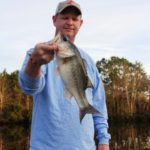
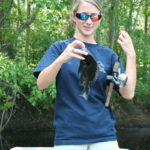
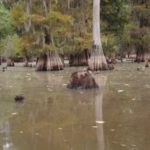
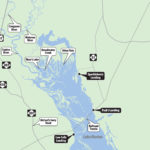




Be the first to comment